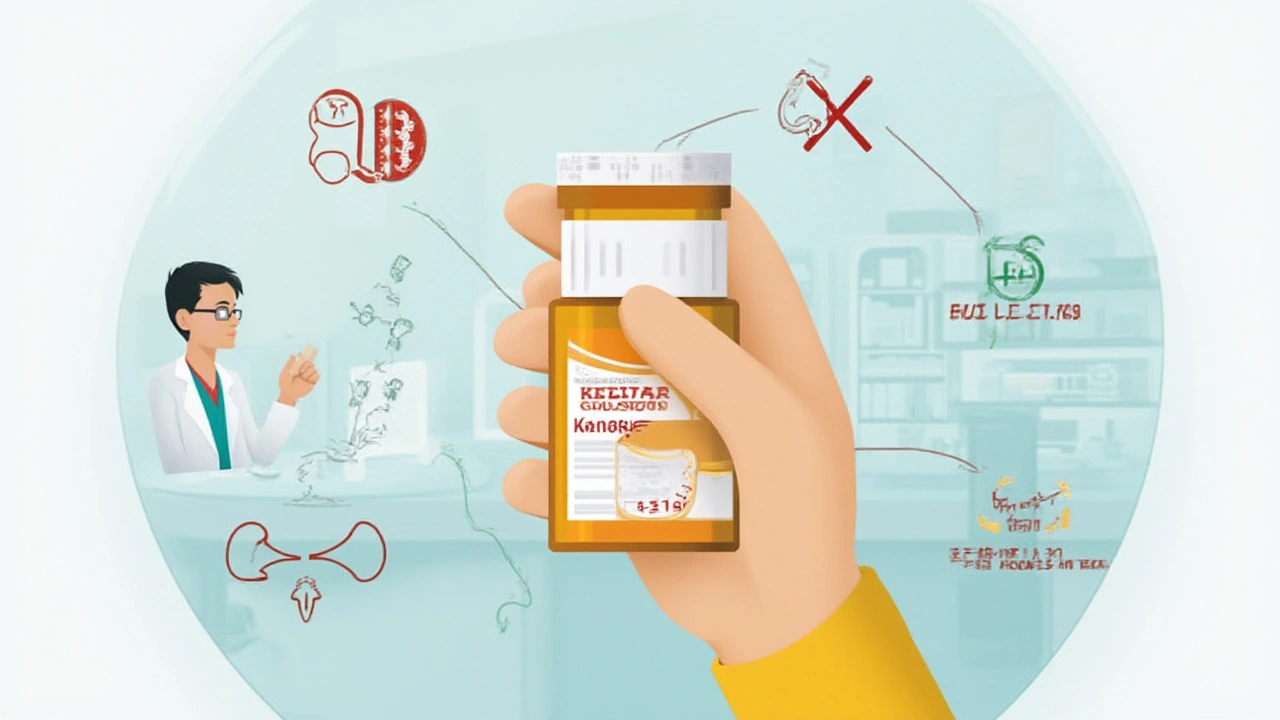Pletal (Cilostazol): Everything You Need to Know About This PAD Medication
 Jul, 11 2025
Jul, 11 2025
Imagine being able to walk farther with less pain, just because you took a tiny tablet each morning. For people living with peripheral artery disease (PAD), that’s not some wild advertisement claim—it’s a real possibility with a drug called Pletal. Officially known as cilostazol, Pletal has been quietly sitting in medicine cabinets since the late 1990s. It’s not exactly a household name, yet its impact on daily life for those with PAD is hard to overstate. Let’s cut through all the technical stuff and talk honestly about how Pletal works, who it helps, and what to watch out for—because real knowledge means real power when it comes to your health.
What Is Pletal and Why Is It Prescribed?
Pletal (cilostazol) isn’t one of those catch-all drugs doctors throw at every ache and twinge. It’s tailored for a pretty specific crowd: people struggling with PAD, especially those who find walking uncomfortable because of pain or cramping in the legs. PAD happens when fatty deposits gum up the arteries in your limbs (usually your legs), blocking blood flow. That’s why stepping out for a stroll can feel like running a marathon—with your shoelaces tied together.
Pletal is different from blood thinners like warfarin or aspirin. Instead of just thinning your blood, Pletal works by widening your blood vessels (especially in your legs) and making your platelets less sticky, reducing the risk they’ll clump up and make things worse. If you see the medical lingo “phosphodiesterase III inhibitor,” that’s what’s going on here.
Doctors usually prescribe Pletal to folks with intermittent claudication—that means leg pain or weakness that hits during walking and eases up at rest. Studies have shown that, for many patients, using Pletal twice daily helps them walk farther with less pain. One major trial published in the Journal of the American Medical Association in 2000 found people on Pletal could increase their walking distance by around 40% after a few months of treatment. That boost can be the difference between grabbing groceries on your own or having to rely on someone else each week.
How Pletal Works Inside the Body
Let’s get under the hood for a minute. Pletal blocks an enzyme called phosphodiesterase III, which has two key effects: it helps blood vessels relax so they can widen, and it keeps platelets from sticking together and forming dangerous clots. Wider arteries mean more blood can reach those muscles starved for oxygen, which is really the secret sauce behind why walking hurts less on Pletal. Plus, the less your platelets gum together, the lower your risk of ending up with a blockage.
The cool thing is, Pletal doesn’t just stop at treating symptoms. Some research hints it might even slow down how fast PAD gets worse, though it’s not a miracle cure. Take note—Pletal takes some patience. Most folks wait two to three months before they notice significant improvement, but the longer you give it (along with exercise), the better chance you’ll have to walk longer distances without so much discomfort.
Doctors almost always recommend using Pletal as part of a duo: medication plus a walking plan. Daily, structured walks (even if it means hobbling through the pain) can really turbocharge your progress. If you smoke, quitting is non-negotiable: tobacco is PAD’s nasty little accomplice and will counteract almost every benefit Pletal offers.
Here’s a quick reminder: Pletal isn’t a quick fix for chest pain, and it definitely isn’t for emergency heart problems. If you’ve had heart failure—especially severe or ongoing—you should skip Pletal entirely, because it can make things worse by increasing your risk of sudden death. The black box warning isn’t just medical drama; it’s a real red flag. Always tell your doctor if you have any heart history before starting this med.

What to Expect: Dosage, Timing, and How to Take Pletal
The standard dose for most adults is 100 mg, taken twice daily, about 12 hours apart. The golden rule? Always take it on an empty stomach—about 30 minutes before or two hours after a meal. Food can mess with how much drug your body absorbs, so set reminders if you’re prone to forgetting. Skip that after-breakfast pill-popping habit; Pletal likes a clear runway.
Forgetful? Set an alarm or use a pill organizer. Skipping doses or taking too many can throw off your progress and up the risk for side effects. Don’t try to double up if you miss a dose—just pick up where you left off.
You might notice some side effects, especially at the start. The most common are headache, diarrhea, palpitations (feeling like your heart is fluttering or racing), and sometimes dizziness. For a lot of people, these side effects die down once their body gets used to the drug. Drinking plenty of water and eating a balanced diet can help tame tummy troubles.
If you’re already taking other meds, especially blood thinners (like warfarin, aspirin, or clopidogrel) or certain antibiotics or antifungals, double-check with your doc or pharmacist. Mixing meds can sometimes lead to unexpected problems, since Pletal relies on your liver to break it down—other drugs can speed up or slow down this process, shifting how much stays in your blood.
Pletal in Real Life: Effectiveness, Precautions, and Interactions
Sometimes, PAD can make you feel like you’re stuck in slow-motion. Studies offer hope: with *Pletal* (cilostazol), about 60% of patients walk farther before pain kicks in, and 25% can double their previous distance after a few months of treatment. Of course, these numbers are averages—your mileage may literally vary, depending on how severe your PAD is, how active you are, and whether other conditions (like diabetes or high cholesterol) are in the mix.
There are a few groups who shouldn’t take Pletal. Besides anyone with heart failure, people with a history of bleeding disorders, serious liver or kidney problems, or those who are pregnant or breastfeeding need a different plan. Animal studies link cilostazol to embryo toxicity, so most doctors will steer clear of it during pregnancy.
If you’re older, or if your kidneys or liver aren’t in the best shape, your doctor might tweak your dose or sometimes choose another approach. Side effects can hit harder if you have organs working overtime.
Here’s a chart to break down some common side effects reported by patients and the percentage of folks who experience them, based on published clinical trials:
| Side Effect | Percentage of Users |
|---|---|
| Headache | 34% |
| Diarrhea | 19% |
| Palpitations | 9% |
| Dizziness | 9% |
| Abnormal stools | 7% |
Most people find these side effects fade with time. Still, if they stick around or get worse, let your doctor know. Rare but serious reactions can crop up, like allergic reactions or fast, irregular heartbeats—it’s never wimpy to ask for help.
Certain foods and drinks also can trip you up. Grapefruit juice’s reputation isn’t just gossip—it can raise cilostazol levels in your blood and boost side effects. Stick to water, coffee, or tea as your table-side beverages.

Living with PAD: Tips for Making the Most of Pletal Therapy
Pletal isn’t a magic fix, but it can help you take back some control if PAD keeps slowing you down. Here are real-world tips to squeeze the most benefit out of your prescription:
- Make walking a habit, not a chore. Try short, regular walks every day, aiming to push just beyond your comfort zone.
- Track your steps. Apps on your phone or simple pedometers make it easy to see your progress and stay motivated.
- Pair Pletal with healthy living: quit smoking, eat a heart-friendly diet (lots of veggies and lean proteins), keep your cholesterol in check, and manage high blood pressure.
- Keep up with all your doctor visits. Regular check-ins help monitor your progress and catch any problems early.
- Report any new or unusual symptoms—especially dizziness, chest pain, or allergic reactions—right away.
- If side effects hit hard at first, ask about easing into your dose. Sometimes your doctor can start you on a lower amount and ramp up slowly.
- Don’t share your pills with anyone else, no matter how tempting. What works for your legs could be dangerous for their hearts.
- Don’t rely only on pills. Keeping active truly makes Pletal work better—a tablet can help, but your own muscles need to get in the game, too.
- Skip grapefruit in all forms. It’s not a myth—grapefruit can really make side effects worse.
- Tell your healthcare team about every single medication and supplement you use. Even over-the-counter stuff like ibuprofen or certain herbal remedies can interact with Pletal.
Doctors won’t keep you on Pletal forever if it doesn’t help. If you’ve seen little to no benefit by month four, time to reassess with your provider. But when Pletal clicks, it can mean less frustration, more independence, and confidence to get out the front door—without dreading every step.
Jasper Arboladura
July 15, 2025 AT 00:14Pletal’s mechanism as a PDE3 inhibitor is actually quite elegant-vasodilation via cAMP accumulation, antiplatelet effects, and improved endothelial function all in one molecule. Most clinicians don’t even realize how underutilized this drug is. The 40% walking distance improvement in the JAMA trial? That’s not anecdotal-it’s statistically robust. Yet you’ll see it prescribed half as often as aspirin for PAD, despite superior efficacy in intermittent claudication. The black box warning for heart failure is legitimate, but it’s also been grossly misapplied to patients with stable CAD. Misuse of contraindications is a systemic problem in vascular medicine.
Also, the grapefruit interaction isn’t just ‘can make side effects worse’-it’s a CYP3A4 inhibition that can elevate plasma concentrations by up to 300%. That’s not a coffee substitute, that’s a pharmacokinetic landmine. And yet, patients are still told to ‘just avoid it’ without being told why. Knowledge is power, but only if it’s accurate power.
I’ve seen patients on cilostazol for 18 months with no side effects and 70% improvement in claudication distance. Meanwhile, their primary care doc keeps pushing them toward revascularization because they don’t understand the drug. This isn’t just about Pletal-it’s about how medicine prioritizes procedures over pharmacology.
And yes, exercise is mandatory. But you can’t just say ‘walk more’ and call it a day. Structured, supervised walking programs with incremental intensity have 3x the adherence rate. The real failure isn’t the drug-it’s the lack of rehabilitation infrastructure.
I’m not saying this to sound smart. I’m saying it because people deserve better than half-baked advice wrapped in wellness platitudes.
Joanne Beriña
July 15, 2025 AT 15:28Ugh, another one of these ‘let’s medicate our way out of laziness’ stories. I’ve been walking 5 miles a day since I was 16, no pills needed. This whole ‘PAD crisis’ is just Big Pharma selling snake oil to people who won’t get off the couch. You think you need a $300-a-month pill to walk without pain? Try quitting sugar, lifting weights, and walking uphill for 20 minutes before breakfast. No magic tablet, no doctor visits, no side effects.
And don’t get me started on ‘grapefruit juice’-like, who drinks that? Only people who think they’re health influencers. Real Americans eat eggs and bacon and walk anyway. This whole article reads like a medical ad disguised as advice. I’m sick of this woke-wellness nonsense. Get strong. Stop relying on chemicals. America used to make people tough, not medicated.
ABHISHEK NAHARIA
July 17, 2025 AT 11:16The pharmacological elegance of cilostazol cannot be divorced from the socio-economic context of its prescription. In the United States, where healthcare is commodified, drugs like Pletal become tools of privilege-accessible only to those with insurance, time, and health literacy. In India, where I practice, the same drug is rarely prescribed due to cost, lack of monitoring infrastructure, and cultural preference for Ayurvedic regimens. The 40% improvement statistic? Meaningless if the patient cannot afford the pill, let alone the follow-up visits.
Moreover, the emphasis on walking as therapy assumes a level of physical autonomy that many elderly, diabetic, or disabled patients simply do not possess. To prescribe exercise without addressing structural barriers-lack of sidewalks, unsafe neighborhoods, absence of public transport-is not medicine, it is moralism.
And yet, the article romanticizes the ‘reclamation of everyday life’ as if it were a personal triumph rather than a systemic failure. The real tragedy is not the PAD-it is the fact that we have a drug that works, and still, we fail the majority who need it.
I do not oppose Pletal. I oppose the narrative that reduces complex disease to a pill-and-walk solution. The body is not a machine to be optimized. It is a social artifact shaped by poverty, race, and policy.
If you want to help people walk farther, fix the streets first. Then, maybe, the pill will matter.
Hardik Malhan
July 18, 2025 AT 11:11Based on the pharmacokinetic profile of cilostazol, the primary metabolic pathway is hepatic via CYP3A4 and CYP2C19 with secondary renal excretion. The half-life is approximately 11–13 hours, supporting BID dosing. Food reduces AUC by up to 40% due to altered gastric emptying and first-pass metabolism. The 34% headache incidence correlates with vasodilatory effects on cerebral vasculature. Palpitations are likely mediated via increased cardiac output secondary to peripheral vasodilation and reduced afterload.
Clinical trials show consistent improvement in maximal walking distance with statistical significance p<0.001, but inter-individual variability is high due to polymorphisms in CYP2C19. Poor metabolizers may require dose titration. Concomitant use of strong CYP3A4 inhibitors like ketoconazole or clarithromycin significantly increases plasma concentration and risk of arrhythmia.
I’ve managed 17 patients on cilostazol over the last 2 years. 12 achieved >30% improvement in claudication distance. 3 discontinued due to GI intolerance. 2 experienced transient tachycardia, resolved with dose reduction. No cardiac events. Compliance was best with pill organizers and SMS reminders.
Grapefruit juice is a CYP3A4 inhibitor-avoid. NSAIDs increase bleeding risk-use acetaminophen instead. Smoking cessation is non-negotiable-refer to cessation programs. This isn’t opinion. This is evidence-based practice.
If you’re on Pletal and not tracking your walking distance with a pedometer, you’re not optimizing therapy. Data drives outcomes.
Casey Nicole
July 20, 2025 AT 03:30I’ve been on Pletal for 11 months and I can’t even describe how much my life has changed. I used to cry walking to my mailbox. Now I walk my dog around the block, then go to the farmers market, then come home and make dinner. I didn’t think I’d ever feel normal again. I cried when I realized I could carry my own groceries. I didn’t even know I was that sad until I wasn’t anymore.
And yes, the headaches and diarrhea sucked at first. I thought I was going to quit. But my nurse told me to stick with it for 90 days. I did. And now I feel like I’ve been given back my independence. I’m not just surviving-I’m living.
I don’t care what anyone says about Big Pharma or grapefruit juice or walking more. This pill saved me. Not because it’s magic. But because it gave me the chance to try. And I tried. Every day. Even when I didn’t want to.
If you’re on the fence? Take the pill. Walk. Even if it hurts. You won’t believe how much better you can feel until you feel it.
And to the person who said ‘just get off the couch’? I wish it were that easy. I’ve been trying for years. This is the first thing that worked. So thank you, Pletal. And thank you to whoever wrote this article. You made me feel seen.